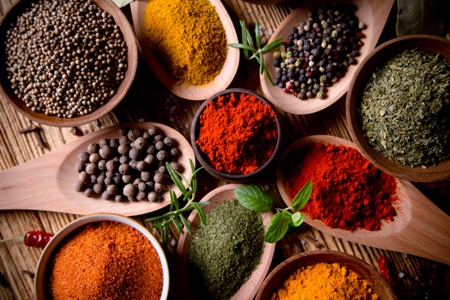 (PCM) So here we are in the second week of November. It’s time to say goodbye to warm weather, fashion scarves and flip-flops. As we head into our dens now, we need to find ways to stay warm, happy and sexy, to thumb our noses at the long, cold shadow of winter. We need to “spice things up,” try out some new “indoor sports” – yeah, you know what I’m talking about, baby.
(PCM) So here we are in the second week of November. It’s time to say goodbye to warm weather, fashion scarves and flip-flops. As we head into our dens now, we need to find ways to stay warm, happy and sexy, to thumb our noses at the long, cold shadow of winter. We need to “spice things up,” try out some new “indoor sports” – yeah, you know what I’m talking about, baby.
We need to get cooking.
“Cook Something Bold and Pungent Day” (November 8th) is one of a smorgasbord of made-up holidays copyrighted (!) by Thomas and Ruth Roy. While much of the Roys’ invented calendar is kind of… out there – consider “Name Your PC Day” (I call mine ‘You Sonuva…’) or “Yell ‘Fudge’ at the Cobras in North America Day” (?!?) – cooking something strong and deliciously stinky is actually a great way to put zing in your dreary November nights – and kick-start your culinary creativity as we roll into the holidays.
“Pungent” means having a strong smell or flavor. It doesn’t have to be bad. Garlic is classically pungent, but is it bold? There is a whole world of choices beyond what most Americans have in their cupboards. If you want a taste of real adventure, why not reach for one of these piquant, odiferous, and maybe new-to-you herbs and spices?
Star anise is the dried, star-shaped fruit of an evergreen tree native to China. While unrelated to European aniseed, star anise has a similar licorice-esque aroma. It is popular in Asian cuisine, where it is used in sweet and savory dishes. It is one of the main components of Chinese Five-Spice, along with Sichuan pepper, cinnamon, cloves and ginger. Star anise is particularly tasty paired with soy sauce, tomato or citrus. When cooking with star anise, a little goes a long way; a few whole pods can imbue intense, fruity flavor to soups, stews, or braises (be sure to remove the pods before serving!). Ground star anise packs more punch; add a teaspoon or two to roasts, stir fry or sauces.
U.S. sumac is a poisonous plant that can give you a helluva rash, but Mediterranean sumac is edible and delicious! The red sumac berry has a strong, sweet-tart flavor reminiscent of lemons. It is a common component of za’atar, a Middle Eastern seasoning along with herbs and spices like thyme, marjoram, oregano, sesame seed, and salt. Dried sumac berries can be steeped in liquid or ground into a powder to add a distinctively bright color and flavor to sauces, salads, soups, dips, dry rubs, grains, legumes, veggies, marinades and beverages.
When crushed or ground, Cardamom seeds have a resinous aroma and strong mint-like zing. Cardamom is used extensively in Indian cooking, especially in curries, desserts and beverages such as chai tea and liqueurs. It popular throughout Asia, and is also an important ingredient in Middle Eastern coffee and Scandinavian mulled wines, sweets, stews and meat dishes. Cardamom seeds are best ground or crushed only as needed; their flavor is quickly lost if you leave them lying around broken. You can remove cardamom seeds from their pods first or grind the whole thing together; the flavor is more intense when separated, but it can be tricky…a labor of love.
Lemongrass is a bulbous herb, similar to a scallion, that is prized for its complex floral, lemony flavor. It is often combined with aromatics such as garlic and chilies, particularly in Thai and other southeast Asian cuisines. Fresh lemongrass is best if stripped of its tough outer layers and sliced thin; it can be added to salads, fish dishes, and stir fry. Try dried Lemongrass whole in
stews, curries, braises or even tea, or chop and sprinkle it on meat, fish, or veggies for a fresh, citrus (but non-acidic!) kick.
Also known as “Grains of Paradise,” Melegueta pepper is not actually a pepper: it is a seed from a leafy plant native to West Africa. It is a common flavoring in the cuisines of West and Northern Africa and Brazil, where it was introduced by slaves brought to the New World. A relative of cardamom, Melegueta pepper is, well, peppery, but also reminiscent of citrus and ginger. It is also a trendy flavoring in vinegar, craft beers, gin, and cordials. You can rub it on meat or sprinkle over vegetables – basically anywhere you would use a pepper mill. In the spirit of being bold, you might also try Melegueta pepper with fruit, jams, or sweet desserts, like you would used cardamom or cloves. Add the seeds whole to your recipes for a mild boost, or ground fresh.
This is just a “for-starters” list; many interesting, piquant, aromatic and unexpected herbs and spices are available in your better-stocked grocery stores. You can also find them in natural food stores, specialty cooking shops, ethnic markets, farmers’ markets or through online purveyors. Wherever you shop, be sure to look for quality and freshness, and ask or look up how to store your ingredients properly so you get the best bang for your culinary buck. But don’t be intimidated – be bold! This could be the season for a whole new, deliciously pungent you.





